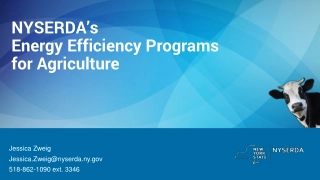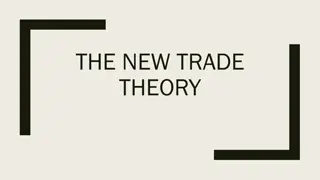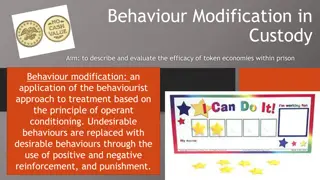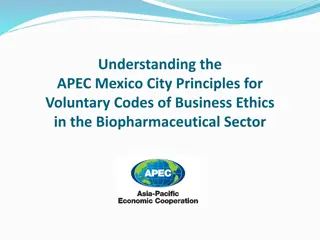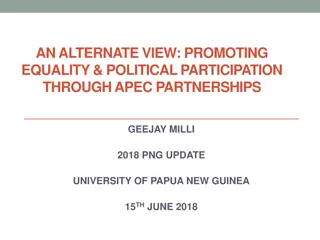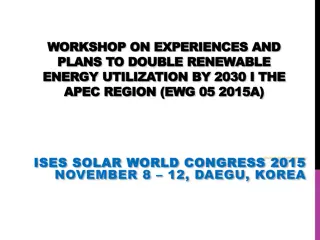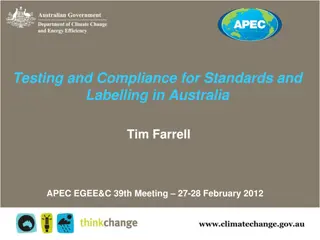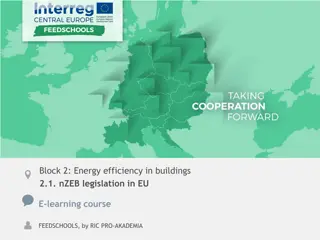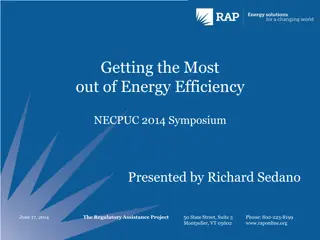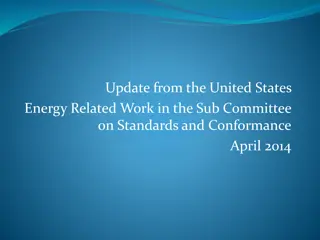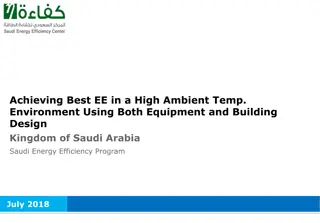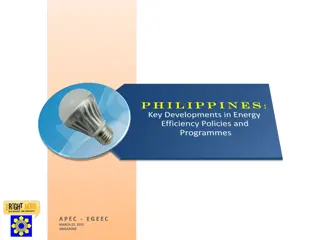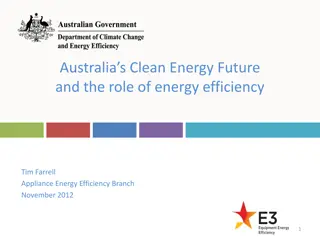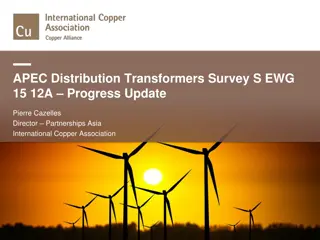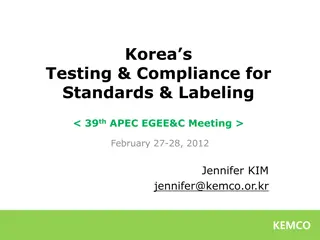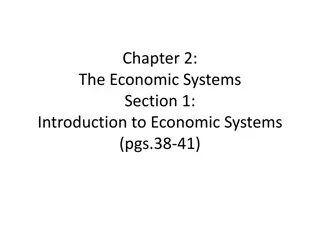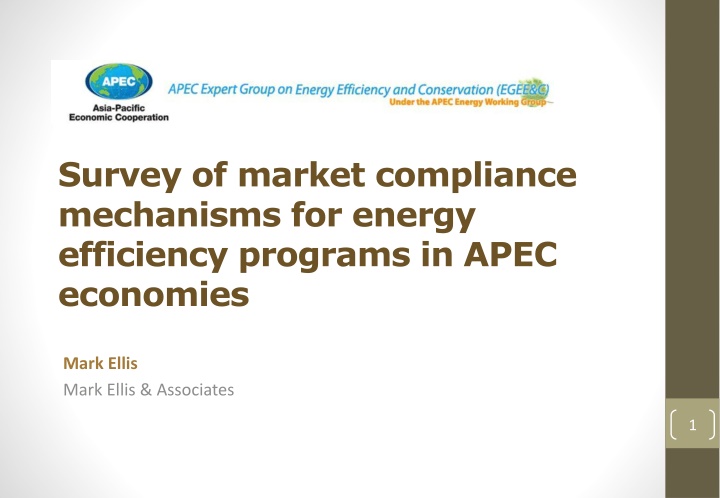
Market Compliance Mechanisms for Energy Efficiency Programs in APEC Economies
This survey explores market compliance mechanisms for energy efficiency programs in APEC economies, discussing terminology, aims of compliance regimes, key elements, and the 2011-12 APEC ECEE&C Project. It delves into mandatory and voluntary programs, scheme design influences, stakeholder obligations, compliance regimes, and best practices for encouraging stakeholder compliance.
Download Presentation

Please find below an Image/Link to download the presentation.
The content on the website is provided AS IS for your information and personal use only. It may not be sold, licensed, or shared on other websites without obtaining consent from the author. If you encounter any issues during the download, it is possible that the publisher has removed the file from their server.
You are allowed to download the files provided on this website for personal or commercial use, subject to the condition that they are used lawfully. All files are the property of their respective owners.
The content on the website is provided AS IS for your information and personal use only. It may not be sold, licensed, or shared on other websites without obtaining consent from the author.
E N D
Presentation Transcript
Survey of market compliance mechanisms for energy efficiency programs in APEC economies Mark Ellis Mark Ellis & Associates 1
Today Context to the APEC EGEE&C Compliance Project Progress with the APEC Compliance Survey Preliminary Results of the Survey Ideas for the Workshop 2
Terminology - what are we talking about? All S&L programs have rules Mandatory and voluntary programs In legislation, regulation or administrative guidelines or a combination The rules establish the processes to be followed by stakeholders The rules vary (although there are only a few basic models) Scheme design influenced by existing legislation, political ambition, national governance issues, resources (in-house and external), stakeholder attitudes, etc Obligations may apply to different stakeholders: suppliers, importers, retailers, wholesalers, on-line suppliers, etc Compliance means adherence to these sets of rules The compliance regime is the monitoring, verification and enforcement processes and activities used by an economy to ensure compliance 3
Aims of compliance regimes Common to Best Practice compliance regimes in many sectors To encourage stakeholders to be compliant: Make sure all stakeholders understand their obligations Minimise the transaction costs for demonstrating compliance Increase the risk that instances of non-compliance will be discovered Take corrective action quickly to minimise damage (to all) Make penalties proportional to the extent of transgression but sufficient to be an effective deterrent Taking corrective action visibly to deter others 4
Key Elements These key elements are interrelated : 1. 2. 3. 4. 5. 6. 7. 8. Facilitate compliance - info & processes Market surveillance Verification testing Enforcement Communication, reporting, feedback Legal and administrative framework Budget Evaluation Effective compliance regimes include all of these elements 5
2011-12 APEC ECEE&C Project APEC Project Survey similar to surveys in Europe (2009) & G20 (2010) for comparable results Phase 1 Conduct Survey of Energy Efficiency Market Compliance Strategies Phase 2 Reporting of results Phase 3 Outreach Workshop on Best Practice 6
Background to the APEC Project 2008: IEA International Conference, Paris: Meeting Energy Efficiency Goals: Enhancing Compliance, Monitoring and Evaluation 2009: Survey of EU Member States (Fraunhoffer) 2010: Survey of EU Member States (ATLETE) 2010: Survey of G20 countries +Tunisia & Chile (CLASP, Ellis) 2010: Compliance Counts: A Practitioner s Guidebook on Best Practice Monitoring, Verification, and Enforcement for Appliance Standards & Labeling (CLASP, Ellis) 2010: IEA Policy Pathways: Improving compliance within equipment energy efficiency programmes 2010: 4E London Conference Saving More Energy Through Compliance 2010/11: Survey of EU Member States (CLASP, Navigant) 2011/12: Survey of APEC economies & Workshop 7
Summary of international & regional activities 2008 2009 2010 2011 2012 International conferences IEA 4E / CLASP APEC Workshop IEA EU EU Surveys EU G20 APEC CLASP Best Practice Publications IEA 8
APEC Project 2008 IEA workshop concluded: Insufficient attention paid to compliance issues by many programs given the impact on savings Opportunities for economies to learn from one another to improve MV&E processes and to collaborate to improve enforcement Need to better understand compliance regimes in different economies and establish mechanism for sharing APEC EGEE&C project an important contribution to this international picture 9
APEC EGEE&C Survey Aims to: Describe the compliance regime in APEC economies for Standards and Labelling (S&L) energy efficiency programs Provide information on compliance activities where possible Identify good practice , interesting approaches, etc Identify common issues, concerns, areas for improvement Compare results to surveys in other regions It does NOT aim to: Compare or rank each economy (no objective measure) 10
Survey procedure Survey designed and distributed to economies Draft country summarie s returned for approval Analysis & draft report for comment Completed surveys returned Follow-up questions Final report Research 11
Economy-Program Coverage Endorsement Label (ENERGY STAR) O O Standards Comparative Label Endorsement Label Australia Canada Chile China PRC O O O Chinese Taipei Hong Kong, China O O Indonesia O Top Runner Japan O Korea Malaysia Mexico O O O KEY New Zealand O Covered (ELI) (ELI) O O Peru Philippines Singapore Thailand USA Vietnam O O O O O O O O Program but not covered O No program 12
APEC survey coverage 18 economies all have one type of program 50 Standards and Labelling programs 0% 10% 20% 30% 40% 50% 60% 70% 80% 90% 100% n = 16 Standards n = 15 Comparative Label n = 13 Endorsement Label Endorsement Label (ENERGY STAR) n = 6 13 Active Programs covered in survey Active Programs not covered in survey
APEC S&L Programs - overview Some mature programs (USA, Australia, Mexico) other new programs (Indonesia, Vietnam, Singapore) Some with many products (USA, Canada, Korea, China) and with fewer products (Malaysia, Philippines) Provides good opportunity to share experience and expertise Some programs under consideration or about to start MV&E regime to be designed (Vietnam, Indonesia, Peru) Some mature programs improving systems (US DOE, US ENERGY STAR, Australia) 14
Issues MV&E design A small number of different models : Third-party certification prior to entry verification by third-party (Canada, US Energy Star, Chile) Registration prior to entry verification government agencies (Australia/NZ, Singapore) Small variations e.g. industry certification Examples of each type that appear to work well 15
Issues - MV&E design Labels Verification tests Third-party certification Not known Not applicable 0% 20% 40% 60% 80% 100% Standards Verification tests Third-party certification Not known Not applicable 0% 20% 40% 60% 80% 100% 16
Issues - legal & organisational framework for MV&E Most programs appear to have adequate legal basis Although some enforcement procedures appear unwieldy Not many examples of public guidelines on MV&E processes Voluntary labels tend to be less regulated Majority of respondents were able to clearly identify the entity or entities responsible for MV&E Market surveillance/monitoring & enforcement may be the responsibility of separate organizations may be justified to avoid the potential for conflicts of interest issues of co-ordination that need addressing 17
Issues - resources Only a few programs replied to questions on overall budgets or expenditure on individual activities Does this indicate: A lack of defined budget allocations? Our contact is sufficiently senior? Unwillingness to divulge? Other? 18
Labelling display surveillance Yes No n.a. no response Are label display surveys conducted? 0% 20% 40% 60% 80% 100% 0% 20% 40% 60% 80% 100% Import controls Visual checks of retail outlets Checks of catalogues Checks of internet sites Checks at trade fairs Other Most labelling programs undertake some market surveillance Increasing in recent years- extending to on-line sales But few have readily available records on the extent follow-up activities 19
Verification testing & enforcement Most programs have some process for verifying claimed performance Quantity of testing varies considerably Individual test costs vary considerably by product some much more expensive Issues of costs (budget) & capacity (capable test facilities) Very little data on enforcement action Issues of record keeping, capacity to respond (human, authority, culture) 20
Public disclosure Labels 0% 20% 40% 60% 80% 100% The number of labelling surveys undertaken Yes No Not Known n.a The results of labelling surveys The number of verification tests conducted, including pass / failure rates Individual products or brands that have failed verification testing 21
Public disclosure Standards Individual products or brands that have failed verification testing Yes No Not known n.a. The number of verification tests conducted, including pass / failure rates 0% 20% 40% 60% 80% 100% Less public disclosure than other regions Applies to MV&E activities and results Tends to be less where third-party certification is involved 22
Preliminary conclusions Findings very consistent with previous studies Programs are increasingly aware they need to address compliance Most programs appear to have adequate legal basis Some enforcement procedures appear unwieldy need to ensure that enforcement actions can be scalable to match degree of transgression All respondents were able to clearly identify the entity or entities responsible for MV&E. MV&E may be the responsibility of separate organizations issues of co-ordination that need addressing Significant number of programs appear to lack planning, implementation, record keeping and reporting Although several are revising compliance regimes Opportunity to improve compliance through more public disclosure Raising perception that non-compliance will be detected and acted upon 23
Finalising the report We wish to make the report as accurate as possible We have communicated with 60 people from 18 economies over several months Drawn information from over 30 other reports All respondents have been very generous with their time! We need a little more effort from each economy to: Ensure that the Draft Summary of your economy is accurate Respond to our questions seeking clarification 24
Workshop proposal 2 Days Day 1: MV&E S&L Program Practitioners Workshop Day 2: MV&E Industry Workshop Dinner between Day 1 & 2 Location Beijing Date June 2012 (to be confirmed) Currently constrained by terms of APEC contract Host China Institute of Standardisation (CNIS) Sponsors CLASP, International Copper Association (ICA), plus others? 25
Day 1 - To share information on best practice in MV&E design and implementation amongst S&L practitioners in APEC economies. - To provide feedback from the survey of MV&E regimes in APEC economies. - To discuss further initiatives to assist in the development of MV&E amongst APEC economies. Aim S&L Program managers and staff responsible for MV&E Related Agency staff where they have a role in MV&E (i.e. enforcement agencies). Mainly government staff. Audience Presentation and discussion of the survey of APEC economies Presentation and discussion of case studies Content Discussion of strengths and weaknesses of MV&E regimes in APEC economies Identification of opportunities for collaborations and other initiatives to support MV&E in the region Number of participants: 15-25 26 CLASP/MEA Best Practice Guidebook Report on APEC Survey Materials
Workshop attendees responses from EGEE&C delegates to date Country APEC Representative to attend conference Australia Shane Holt, Tim Farrell and Simone Tiele Chile Virginia Zalaquett, Marcelo Padilla Hong Kong TBA Indonesia Totok Sulistiyanto, Feby Misna, Mr. Harris Japan TBA Malaysia TBA Mexico Fernando Hernandez Pensado Philippines Raquel Huliganga, Genesis Ramos Thailand TBA 27
Day 2 - To provide the opportunity for a dialogue between major suppliers and managers of S&L Programs on MV&E issues. - For APEC economies (and perhaps others, e.g. Europe) to explain their MV&E processes to industries supplying appliances. - To discuss further initiatives to assist in the development of MV&E amongst APEC economies. Aim Representatives from industry associations in APEC region Representatives from major test laboratories Managers of S&L Programs Audience Presentation and discussion of MV&E regimes in a selection of major economies Presentation by industry of case study experiences of MV&E processes within companies challenges and barrier Content Discussion of opportunities: - to reduce compliance burdens - for collaborations & initiatives to support MV&E in the region Number of participants: Approx 50 28 Materials Report on APEC Survey
MV&E Workshop organisation Fix date of workshop Invite participants for Day 1 from APEC economies Identify invitees for industry day EGEE&C DELEGATES assist? CNIS issue invitations Finalise Agendas Approach speakers Take bookings Organise catering/dinner Can we do all this by June? 29
Thank you Mark Ellis mark@energyellis.com +612 4360 2931 30
Improving MV&E regimes Personal opinion MV&E regimes need sustained investment to plan, establish processes and train staff Most programs need to plan their approach to MV&E better, and more resources to organise and implement MV&E The transference of information in MV&E between countries provides an effective means to promote good practice rapidly. Enforcement capacity can be built through the sharing of data between programs. Dialogue with participating industry often reveals better ways to integrate MV&E at lower cost. Greater exploration of industry certification and other schemes. Programs are always changing lots of opportunities to do things better! 31
Possibilities amongst APEC economies - personal opinion Test facilities Better understand the testing capabilities across the region Explore ideas for mutual recognition & shared testing resources Share experiences with testing facilities Verification testing Share results (see Asia Lighting Compact), notify enforcement actions Explore opportunities for co-ordinated testing Explore industry role i.e. certification Facilitation Mechanism for communication amongst programs - Regional network of regulators/MV&E authorities (See ADCO in EU) 32

